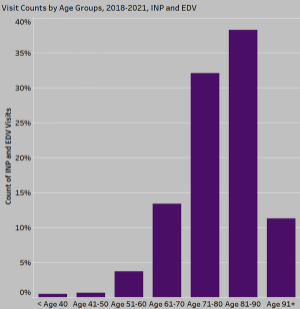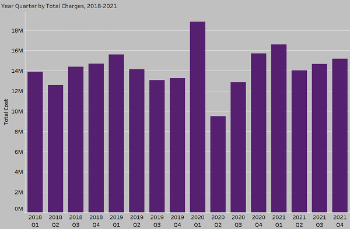Vol. 66, Issue 22
View more issues of The Valued Voice
Sign Up for WHA's Newsletter
Click here to view past issues
IN THIS ISSUE
- Insurers Fail to Follow Through on Agreed-to Prior Authorization Reforms
- Joint Finance Committee Approves $205 Million for Health Insurers
- WHA Workforce Council Explores How to Leverage Technology to Support the Health Care Workforce
- WHA Health Care Leadership Academy Participants Explore “Why Effective Advocacy is a Critical Skill for Health Care Leaders”
- Fast Facts from the WHA Information Center: Alzheimer’s and Brain Awareness
EDUCATION EVENTS
Jan. 14, 2026
Caring for Wisconsin’s Caregivers Well-Being First Champion Challenge for Credentialing KickoffJan. 28, 2026
2026 WHA Health Care Leadership AcademyFeb. 25, 2026
2026 Advocacy DayClick here to view education event calendar
View more issues of The Valued Voice
Sign Up for WHA's Newsletter
Thursday, June 2, 2022
 June is recognized as Alzheimer’s and Brain Awareness Month to bring attention to and spread the word about Alzheimer’s disease and other dementia-related conditions. The Alzheimer’s Association states that worldwide, there are more than 55 million people who are living with Alzheimer’s or some other form of dementia. In 2020, according to the Centers for Disease Control and Prevention (CDC), as many as 5.8 million Americans were living with Alzheimer’s disease. The CDC expects that number to climb to about 95 million by 2060. Currently, Alzheimer’s is ranked as the sixth leading cause of death among U.S. adults. The number of people who live with Alzheimer’s doubles every five years after the age of 65. In more than 90% of cases of Alzheimer’s, symptoms do not show until after age 60. In 2018, the total cost for health care for those with dementia and Alzheimer’s disease was estimated to be $277 billion.
June is recognized as Alzheimer’s and Brain Awareness Month to bring attention to and spread the word about Alzheimer’s disease and other dementia-related conditions. The Alzheimer’s Association states that worldwide, there are more than 55 million people who are living with Alzheimer’s or some other form of dementia. In 2020, according to the Centers for Disease Control and Prevention (CDC), as many as 5.8 million Americans were living with Alzheimer’s disease. The CDC expects that number to climb to about 95 million by 2060. Currently, Alzheimer’s is ranked as the sixth leading cause of death among U.S. adults. The number of people who live with Alzheimer’s doubles every five years after the age of 65. In more than 90% of cases of Alzheimer’s, symptoms do not show until after age 60. In 2018, the total cost for health care for those with dementia and Alzheimer’s disease was estimated to be $277 billion.
 The WHA Information Center analyzed inpatient and emergency department claims in Wisconsin from 2018-2021 to see how Alzheimer’s affects hospital patients in the state. More than 40% of all Alzheimer’s-related visits made during that time were from people between the ages of 81 and 90. The average age of patients was 79. There was no difference in visits between genders, which is on trend with national data. Neither gender is more likely to develop Alzheimer’s or other forms of dementia than the other.
The WHA Information Center analyzed inpatient and emergency department claims in Wisconsin from 2018-2021 to see how Alzheimer’s affects hospital patients in the state. More than 40% of all Alzheimer’s-related visits made during that time were from people between the ages of 81 and 90. The average age of patients was 79. There was no difference in visits between genders, which is on trend with national data. Neither gender is more likely to develop Alzheimer’s or other forms of dementia than the other.
 According to the CDC, the top-five working signs for Alzheimer’s are as follows:
According to the CDC, the top-five working signs for Alzheimer’s are as follows:
Fast Facts from the WHA Information Center: Alzheimer’s and Brain Awareness
 June is recognized as Alzheimer’s and Brain Awareness Month to bring attention to and spread the word about Alzheimer’s disease and other dementia-related conditions. The Alzheimer’s Association states that worldwide, there are more than 55 million people who are living with Alzheimer’s or some other form of dementia. In 2020, according to the Centers for Disease Control and Prevention (CDC), as many as 5.8 million Americans were living with Alzheimer’s disease. The CDC expects that number to climb to about 95 million by 2060. Currently, Alzheimer’s is ranked as the sixth leading cause of death among U.S. adults. The number of people who live with Alzheimer’s doubles every five years after the age of 65. In more than 90% of cases of Alzheimer’s, symptoms do not show until after age 60. In 2018, the total cost for health care for those with dementia and Alzheimer’s disease was estimated to be $277 billion.
June is recognized as Alzheimer’s and Brain Awareness Month to bring attention to and spread the word about Alzheimer’s disease and other dementia-related conditions. The Alzheimer’s Association states that worldwide, there are more than 55 million people who are living with Alzheimer’s or some other form of dementia. In 2020, according to the Centers for Disease Control and Prevention (CDC), as many as 5.8 million Americans were living with Alzheimer’s disease. The CDC expects that number to climb to about 95 million by 2060. Currently, Alzheimer’s is ranked as the sixth leading cause of death among U.S. adults. The number of people who live with Alzheimer’s doubles every five years after the age of 65. In more than 90% of cases of Alzheimer’s, symptoms do not show until after age 60. In 2018, the total cost for health care for those with dementia and Alzheimer’s disease was estimated to be $277 billion. The WHA Information Center analyzed inpatient and emergency department claims in Wisconsin from 2018-2021 to see how Alzheimer’s affects hospital patients in the state. More than 40% of all Alzheimer’s-related visits made during that time were from people between the ages of 81 and 90. The average age of patients was 79. There was no difference in visits between genders, which is on trend with national data. Neither gender is more likely to develop Alzheimer’s or other forms of dementia than the other.
The WHA Information Center analyzed inpatient and emergency department claims in Wisconsin from 2018-2021 to see how Alzheimer’s affects hospital patients in the state. More than 40% of all Alzheimer’s-related visits made during that time were from people between the ages of 81 and 90. The average age of patients was 79. There was no difference in visits between genders, which is on trend with national data. Neither gender is more likely to develop Alzheimer’s or other forms of dementia than the other. According to the CDC, the top-five working signs for Alzheimer’s are as follows:
According to the CDC, the top-five working signs for Alzheimer’s are as follows:- Memory loss that disrupts daily life: forgetting events, repeating yourself or relying on more aids to help you remember (like sticky notes or reminders).
- Challenges in planning or solving problems: having trouble paying bills or cooking recipes you have used for years.
- Difficulty completing familiar tasks at home, at work, or at leisure: having problems with cooking, driving places, using a cell phone or shopping.
- Confusion with time or place: having trouble understanding an event that is happening later or losing track of dates.
- Trouble understanding visual images and spatial relations: having more difficulty with balance or judging distance, tripping over things at home, or spilling or dropping things more often.
Vol. 66, Issue 22
Thursday, June 2, 2022
Fast Facts from the WHA Information Center: Alzheimer’s and Brain Awareness
 June is recognized as Alzheimer’s and Brain Awareness Month to bring attention to and spread the word about Alzheimer’s disease and other dementia-related conditions. The Alzheimer’s Association states that worldwide, there are more than 55 million people who are living with Alzheimer’s or some other form of dementia. In 2020, according to the Centers for Disease Control and Prevention (CDC), as many as 5.8 million Americans were living with Alzheimer’s disease. The CDC expects that number to climb to about 95 million by 2060. Currently, Alzheimer’s is ranked as the sixth leading cause of death among U.S. adults. The number of people who live with Alzheimer’s doubles every five years after the age of 65. In more than 90% of cases of Alzheimer’s, symptoms do not show until after age 60. In 2018, the total cost for health care for those with dementia and Alzheimer’s disease was estimated to be $277 billion.
June is recognized as Alzheimer’s and Brain Awareness Month to bring attention to and spread the word about Alzheimer’s disease and other dementia-related conditions. The Alzheimer’s Association states that worldwide, there are more than 55 million people who are living with Alzheimer’s or some other form of dementia. In 2020, according to the Centers for Disease Control and Prevention (CDC), as many as 5.8 million Americans were living with Alzheimer’s disease. The CDC expects that number to climb to about 95 million by 2060. Currently, Alzheimer’s is ranked as the sixth leading cause of death among U.S. adults. The number of people who live with Alzheimer’s doubles every five years after the age of 65. In more than 90% of cases of Alzheimer’s, symptoms do not show until after age 60. In 2018, the total cost for health care for those with dementia and Alzheimer’s disease was estimated to be $277 billion. The WHA Information Center analyzed inpatient and emergency department claims in Wisconsin from 2018-2021 to see how Alzheimer’s affects hospital patients in the state. More than 40% of all Alzheimer’s-related visits made during that time were from people between the ages of 81 and 90. The average age of patients was 79. There was no difference in visits between genders, which is on trend with national data. Neither gender is more likely to develop Alzheimer’s or other forms of dementia than the other.
The WHA Information Center analyzed inpatient and emergency department claims in Wisconsin from 2018-2021 to see how Alzheimer’s affects hospital patients in the state. More than 40% of all Alzheimer’s-related visits made during that time were from people between the ages of 81 and 90. The average age of patients was 79. There was no difference in visits between genders, which is on trend with national data. Neither gender is more likely to develop Alzheimer’s or other forms of dementia than the other. According to the CDC, the top-five working signs for Alzheimer’s are as follows:
According to the CDC, the top-five working signs for Alzheimer’s are as follows:- Memory loss that disrupts daily life: forgetting events, repeating yourself or relying on more aids to help you remember (like sticky notes or reminders).
- Challenges in planning or solving problems: having trouble paying bills or cooking recipes you have used for years.
- Difficulty completing familiar tasks at home, at work, or at leisure: having problems with cooking, driving places, using a cell phone or shopping.
- Confusion with time or place: having trouble understanding an event that is happening later or losing track of dates.
- Trouble understanding visual images and spatial relations: having more difficulty with balance or judging distance, tripping over things at home, or spilling or dropping things more often.
IN THIS ISSUE
- Insurers Fail to Follow Through on Agreed-to Prior Authorization Reforms
- Joint Finance Committee Approves $205 Million for Health Insurers
- WHA Workforce Council Explores How to Leverage Technology to Support the Health Care Workforce
- WHA Health Care Leadership Academy Participants Explore “Why Effective Advocacy is a Critical Skill for Health Care Leaders”
- Fast Facts from the WHA Information Center: Alzheimer’s and Brain Awareness

